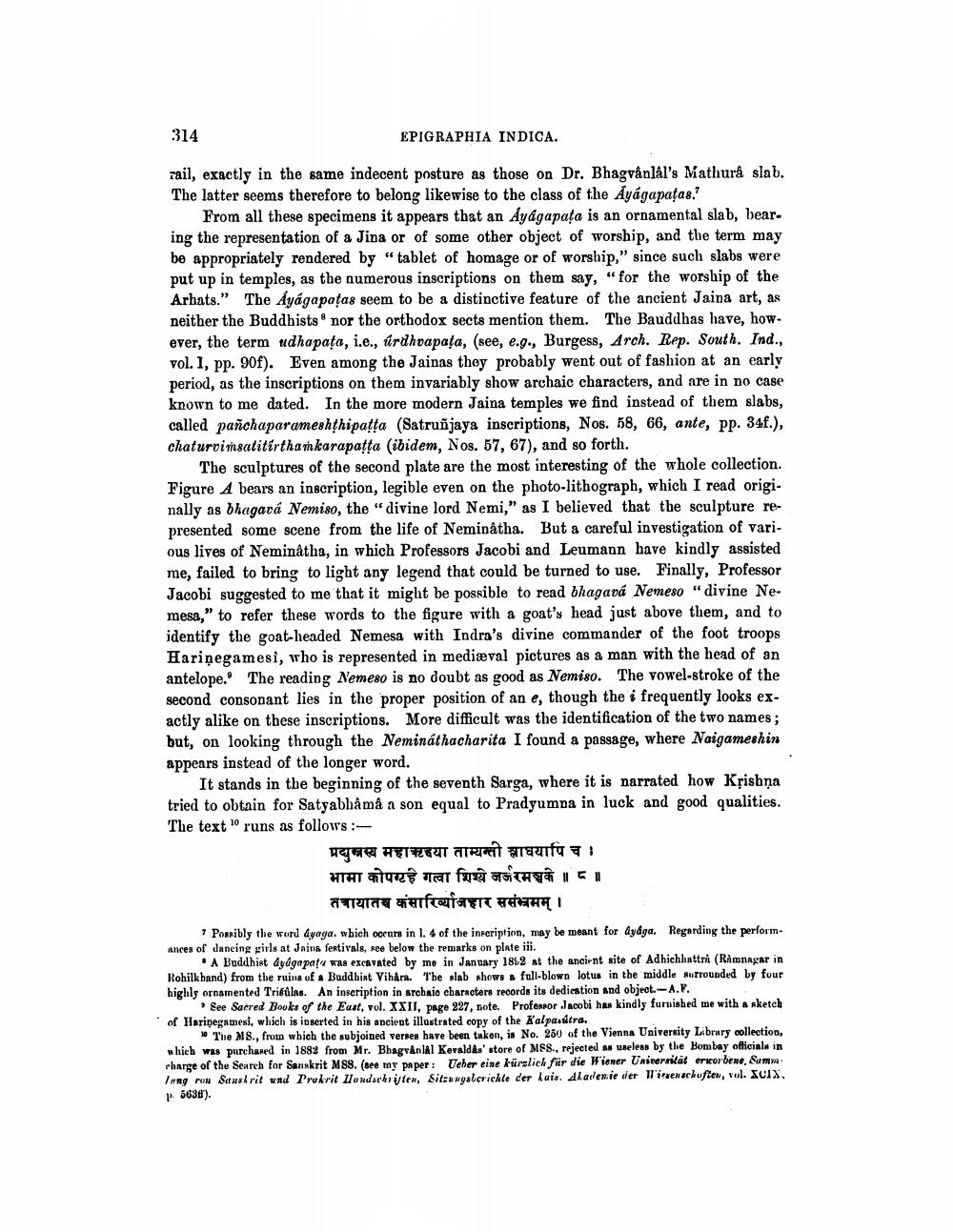________________
314
EPIGRAPHIA INDICA.
rail, exactly in the same indecent posture as those on Dr. Bhagvânlal's Mathura slab. The latter seems therefore to belong likewise to the class of the Ayágapatas.
From all these specimens it appears that an Ayagapata is an ornamental slab, bear. ing the representation of a Jina or of some other object of worship, and the term may be appropriately rendered by "tablet of homage or of worship,” since such slabs were put up in temples, as the numerous inscriptions on them say, "for the worship of the Arhats." The Ayága patas seem to be a distinctive feature of the ancient Jaina art, as neither the Buddhists nor the orthodox sects mention them. The Bauddhas have, however, the term udhapata, i.e., úrdhvapața, (see, e.g., Burgess, Arch. Rep. South. Ind., vol. 1, pp. 90f). Even among the Jainas they probably went out of fashion at an early period, as the inscriptions on them invariably show archaic characters, and are in no case known to me dated. In the more modern Jaina temples we find instead of them slabs, called pañchaparameshthipatta (Satruñjaya inscriptions, Nos. 58, 66, ante, pp. 34f.), chaturvimsalitirtham karapatta (ibidem, Nos. 57, 67), and so forth.
The sculptures of the second plate are the most interesting of the whole collection. Figure A bears an inscription, legible even on the photo-lithograph, which I read originally as bhagavá Nemiso, the “divine lord Nemi," as I believed that the sculpture represented some scene from the life of Neminatha. But a careful investigation of various lives of Neminátha, in which Professors Jacobi and Leumann have kindly assisted me, failed to bring to light any legend that could be turned to use. Finally, Professor Jacobi suggested to me that it might be possible to read bhagavá Nemeso "divine Nemesa," to refer these words to the figure with a goat's head just above them, and to identify the goat-headed Nemesa with Indra's divine commander of the foot troops Harinegamesi, who is represented in mediæval pictures as a man with the head of an antelope. The reading Nemeso is no doubt as good as Nemiso. The vowel-stroke of the second consonant lies in the proper position of an e, though the i frequently looks exactly alike on these inscriptions. More difficult was the identification of the two names; but, on looking through the Nemináthacharita I found a passage, where Naigameshin appears instead of the longer word.
It stands in the beginning of the seventh Sarga, where it is narrated how Kșishņa tried to obtain for Satyabhama a son equal to Pradyumna in luck and good qualities. The text runs as follows:
प्रद्युम्नस्य महाऋइया ताम्यन्ती श्लाघयापि च । भामा कोपग्रह गत्वा शिश्ये जर्जरमञ्चके ॥ ८॥ तचायातच कंसारिाजहार ससंभ्रमम ।
* Possibly the word dyaga, which occurs in l. 4 of the inscription, may be meant for dydga. Regarding the performances of dancing girls at Jaina festivals, nee below the remarks on plate iii.
A Buddhist dydgapata was excavated by me in January 1852 at the ancient site of Adhichhattra (Ramnagar in Rohilkhand) from the ruins of a Buddhist Vihara. The slab shows full-blown lotus in the middle surrounded by four highls ornamented Trikülas. An inscription in archais characters records its dedication and object.-A.F.
Bee Sacred Books of the Eust, vol. XXII, page 227, Lote. Professor Jacobi has kindly furnished me with a sketch of Harinegamesl, which is inserted in his ancient illustrated copy of the Kalpasitra.
The MS., froin which the subjoined verses have been taken, is No. 260 of the Vienna University Library collection, which was purchased in 1882 from Mr. Bhagvånial Kevaldas' store of M88., rejected as useless by the Bombay officials in charge of the Search for Sanskrit MS8. (see my paper: Ueber eine kürzlich für die Wiener Universität erworbene, cum Ingron Sanskrit und Prukrit Ilondach vten, Sitzungslerichte der kuis. Aladenie der Wirenachuften, vol. XIX, p. 5638).




